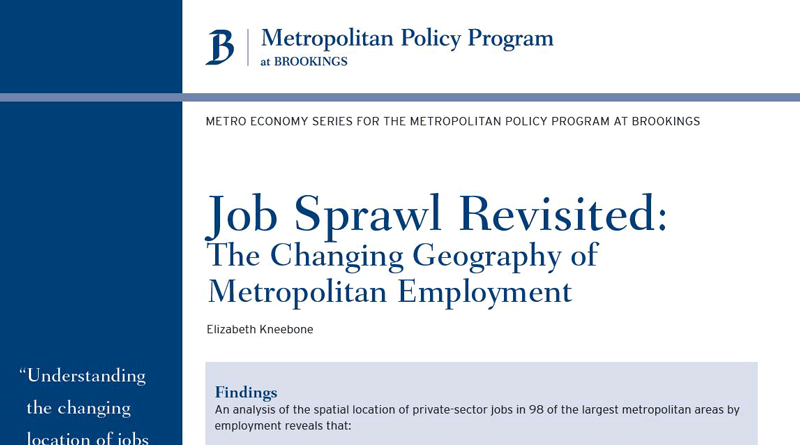Job Sprawl Revisited: The Changing Geography of Metropolitan Employment. (2009). Elizabeth Kneebone, The Brookings Institution.
While much has been made in the past about the impact of sprawling housing developments on the environment, transportation patterns, and the economy, a new analysis by the Brookings Institution sheds light on the decentralization of employment that took place in nearly all of the country’s 98 largest metropolitan areas between 1998 and 2006. Jobs Sprawl Revisited: The Changing Geography of Metropolitan Employment examines the spatial distribution of private-sector jobs in these metro areas by employment sectors and finds that an increasing proportion of jobs are located outside of downtowns. The report cautions that when jobs shift away from city centers, the result is unsustainable and energy inefficient development patterns that rely heavily on single-occupancy automobile travel; thereby increasing vehicle miles traveled (VMT), energy consumption, and emissions in the region. In turn, this makes transit-oriented development all the more difficult to implement effectively and efficiently.
Specifically, the findings reveal that:
- Only 21 percent of employees in the top 98 metro areas work within three miles of downtown, while over twice that share (45 percent) work more than 10 miles away from the city center. The larger the metro area, the more likely people are to work more than 10 miles away from downtown.
- Job location within metropolitan areas varies widely across industries. Jobs in utilities, finance, insurance, and educational services locate within three miles of downtowns, while jobs in manufacturing, construction, and retail are more than 10 miles outside central business districts.
- Employment steadily decentralized between 1998 and 2006: 95 out of 98 metro areas saw a decrease in the share of jobs located within three miles of downtown. While the number of jobs experienced an overall increase in the top 98 metro areas increased, the outer-most parts of these metro areas saw employment increases of 17 percent, compared to less than one percent in the urban core.
- In almost every major industry, jobs shifted away from city centers between 1998 and 2006.The study examined 18 industries, of which 17 experienced employment decentralization. Transportation and warehousing, finance and insurance, utilities, real estate, and rental and leasing experienced the largest increases in percentage of jobs located more than 10 miles away from downtown.
In the two metropolitan areas that envelop New Jersey—New York-Northern New Jersey-Long Island-NJ-PA and Philadelphia-Camden-Wilmington-PA-NJ-DE-MD—we see from the table below that the NYC area fared slightly better than the national average in terms of jobs sprawl, but the Philadelphia area fared worse. However, there is clearly room for significant improvement in both regions if we are to continue developing in transit-friendly ways.

